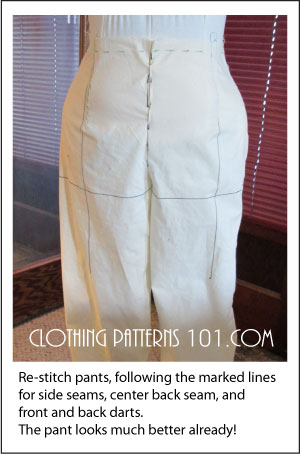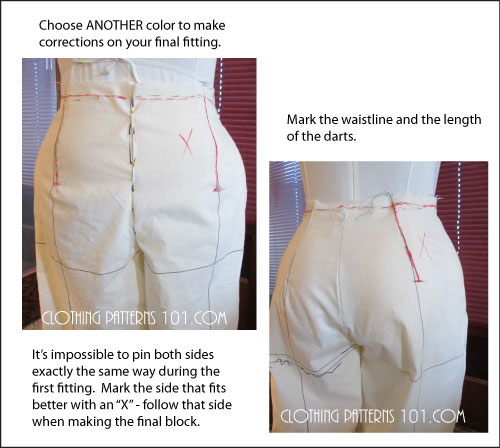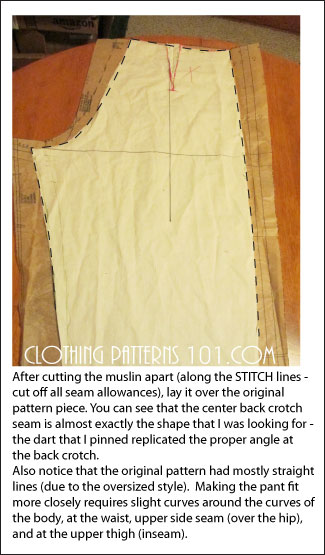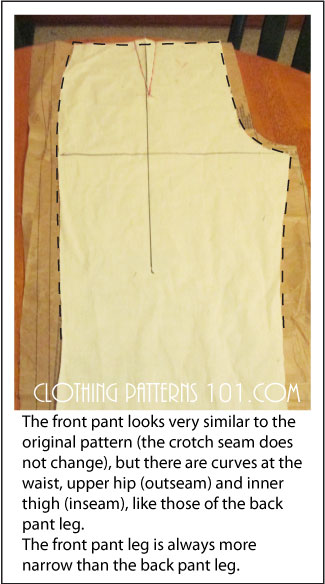- Clothing Patterns 101
- Using the Fitting Pattern
- Fitting the Pants Block - Final Fitting
Final Fitting of the Pants Block
We've completed the initial fitting of the pants block. Now we'll take a look at the pant after the initial adjustments have been made.
After marking the changes on your initial pant fitting, you'll re-stitch the pant along the marked lines.
In addition to marking the new seam lines and dart lines, please note that I also marked the waistline on the pant (below).
The pant looks much better already!
Now, mark any other changes you want to make, using a different color pen. I used red (see photos, below).
I really didn't feel this needed any more changes, so I just marked darts at the correct length (they weren't usually the same length on each side), evened out the waistline, and marked an "X" on the side of the pant that fit best.
It's virtually impossible to pin each side of the pant exactly the same way. Look closely at the pant on the form (or, ideally, on yourself), and mark the side that looks best. When you take the pant apart, THAT is the side that you will copy for your block.
Take the pant apart along the stitch lines, cutting off ALL seam allowances.
I laid the new pant over the original paper pattern so you can see the changes more clearly.
The original pant had very straight sides and center back seam, to allow the pant to be pulled on without a zipper. The pant was drawn in at the waist with a drawstring or elastic rather than shaped with darts and curved seams.
Pay special attention to the center back crotch seam. The original is straight up from the curve, which is not typical of a fitted pant (again, this was meant to add fullness at the waist for ease of wear). After pinching out the "dart" shape at that seam, the new shape is much more typical of a back crotch seam - angled away from the curve. It fits much better over the buttocks that way!
You can also see that the side seams and the inseam have a bit of shape instead of the straight, boxy leg of the original. It's still a fairly full leg, but there is some shape at the hip and inside the leg (to balance the adjustments to the outer leg seam).
The front pant didn't change nearly as much as the back. The crotch curve of the front is fine; the front crotch seam SHOULD be straight up from the curve. There is no angle or "dart" in the front.
The curves at the hip (outer seam) and thigh (inseam) match those of the back leg.
The front leg is not as wide as the back, but it wasn't on the original pattern, either. A front leg should always be more narrow than the back.
This pant (the muslin version) can now be traced to cardstock and marked, as you did with the dress block.
What's the Next Step?
You're ready to start designing pants! Flared (or boot cut), tapered, shaped yokes - there are lots of options!
Step-by-Step: Making and Fitting Your Block
- Make Clothes that Fit You Perfectly
- Using Fitting Patterns
- A Beginner's Guide to Drafting a Dress Block
- Fitting the Bodice Pattern
- Full Bust Adjustment
- Fitting the Sleeve Pattern
- Fitting the Skirt Pattern
- Making Your Personal Pattern Block
- Making a Women's Blouse Block
- Fitting the Pants - Initial Fitting
- Fitting the Pants - Final Fitting
- A Beginner's Guide to Drafting a Pant Block
- The Importance of Sewing Darts
- Pattern Grading
Need More Help with Fitting Issues?
The examples on this site reflect MY fitting issues and how I resolved them. Your body is likely very different.
But, since this is a site about the mechanics of making patterns and not specifically about fitting, I'm not going to address other fit issues here. And believe me, there are others who can address this issue better than me.
Any of the books listed below will help you achieve good fit. You can use the techniques on any pattern; but why make the same corrections over an over again? Apply the principles to your block, and the fit corrections YOU need will be automatically built in to every pattern you make!
I can recommend any of the following books and an online course to help you achieve good fit, no matter what your size or shape. I own or have used almost all of the books on this list, and have been pleased with how they address fit problems.
Click on the TEXT links below to go to the item in Amazon. As an Amazon Associate I earn from qualifying purchases. This helps to keep this site free for your use. You are free to search Amazon for these or other similar items without using the affiliate links on this page.
- Sewing Pattern Alterations: Fixing Fit Issues - This online course from Udemy is essential for creating clothing with a good fit. There's nothing worse than spending time and money on making a garment, only to find it doesn't fit well! Learn how to fix the pattern BEFORE you cut into your fabric! The course covers necklines, sleeves, skirts and pants.
• Pattern Fitting With Confidence - A very useful book written by the late Nancy Zieman, host of the TV series "Sewing with Nancy". She provides a straightforward, down-to-earth approach to sewing and fitting. Very user-friendly.
• The Complete Photo Guide to Perfect Fitting - I love this book!!! So wonderfully illustrated with photos, using commercial patterns to demonstrate the pattern alterations. It addresses almost any fit problem you might have. So easy to understand and follow!
• Sewing for Plus Sizes - Creating Clothes that Fit and Flatter - A great book for Plus sizes! As a woman gets larger, it's not just the measurements that change - our overall proportions shift, too. This book addresses the different body types and proportions you commonly see in larger women. Truly helpful for larger women.
Return to Clothing Patterns 101 Home Page
ClothingPatterns101.com does not sell the personal information of its users to anyone, ever.




